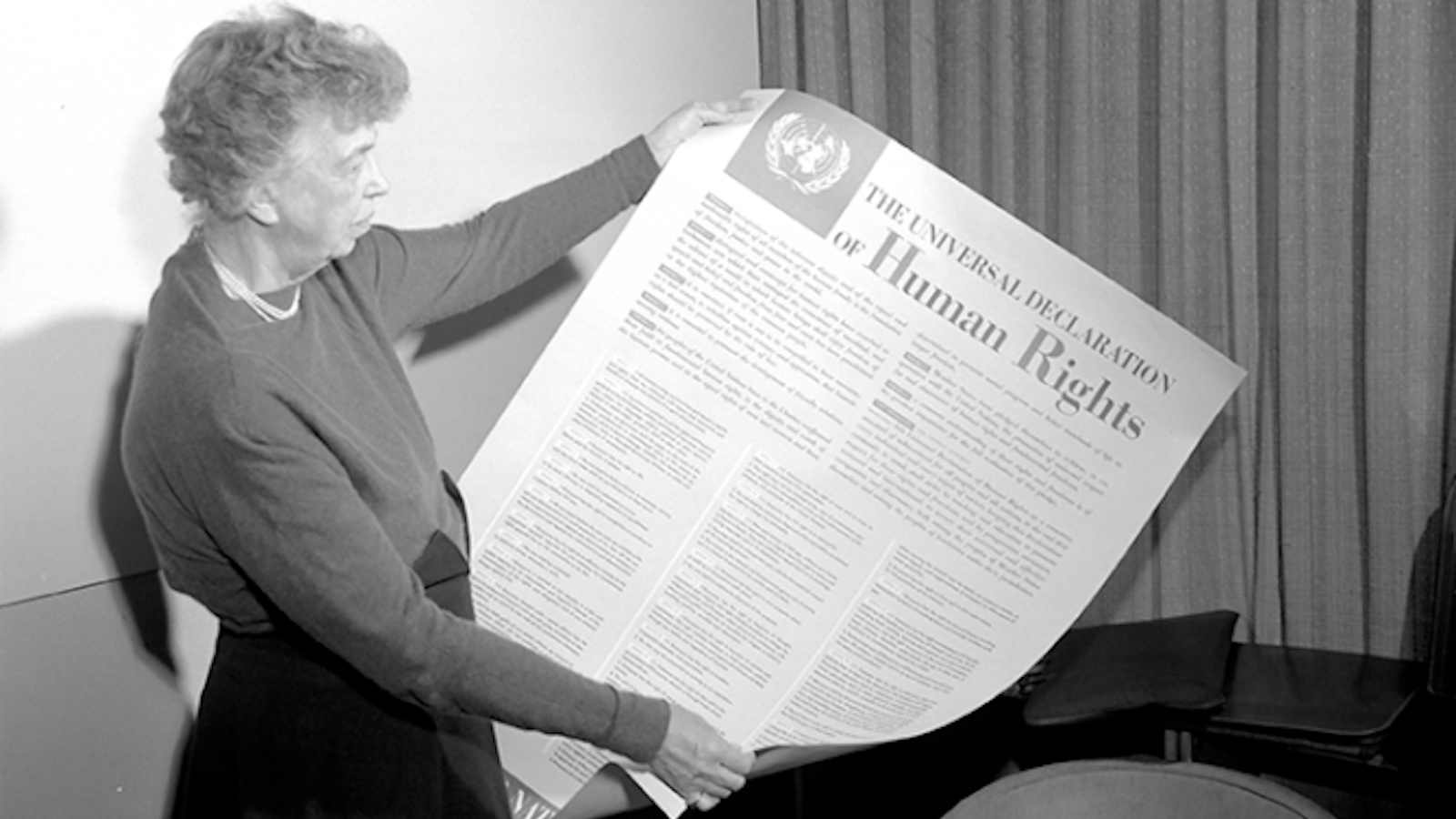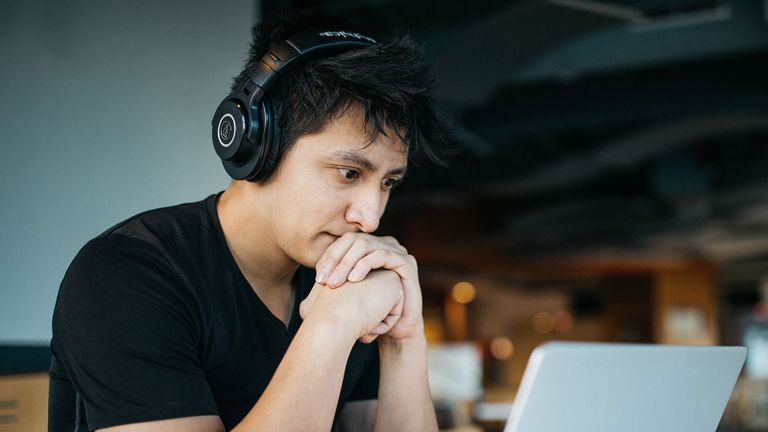
Events /
- This event has passed.
"My Most Important Task": Eleanor Roosevelt and the Universal Declaration of Human Rights

Roosevelt House opens New Exhibition: "My Most Important Task": Eleanor Roosevelt and the Universal Declaration of Human Rights
Commemorates Eleanor Roosevelt’s leadership in the creation of the Universal Declaration of Human Rights on its 70th anniversary
To mark the 70th anniversary of the adoption of the Universal Declaration of Human Rights by the United Nations, the Roosevelt House Public Policy Institute at Hunter College presents a new exhibition, “My Most Important Task:” Eleanor Roosevelt and the Universal Declaration of Human Rights.
The show focuses through text and images on events leading up to the founding of the United Nations, in which President Franklin D. Roosevelt played a central role, and then traces the critical leadership role played by former First Lady Eleanor Roosevelt in the creation of the UN’s Universal Declaration. From 1946 to 1948, she deployed her extraordinary skills to manage the drafting and debate on this unique document, which led to its unanimous adoption by the UN on December 10, 1948.
The Declaration transformed the understanding of human rights, in its ideals and aspirations for all the peoples of the world. Today, there is no concept more widely discussed on a daily basis some place in the world than human rights.
Fittingly, “My Most Important Task” will open to the public on October 11, Eleanor Roosevelt’s 134th birthday. That evening at 6 PM, Roosevelt House will present Human Rights Today, a free program (online reservations required), featuring Assistant Secretary-General Andrew Gilmour, United Nations High Commissioner for Human Rights, in conversation with Jessica Neuwirth, the new Rita Hauser Director of the Roosevelt House Human Rights Program, and Babatunde Olugboji, Associate Program Director at Human Rights Watch.
“Roosevelt House is the most appropriate setting in New York City to mount this important show,” commented Jennifer J. Raab, president of Hunter College. “Our public policy institute, which operates from this onetime home of Franklin and Eleanor Roosevelt, is devoted to bringing their enlightened and innovative approaches to public policy and human rights to new generations of students, faculty, and the general public.
“We are gratified that it is now hosting a commemoration of Eleanor Roosevelt’s work in transforming the understanding of human rights around the world. For all of our guests, the exhibit could not be a more timely reminder that there is yet much work yet to be done to achieve global human rights for all.”
Commented Harold Holzer, the Jonathan F. Fanton Director of Roosevelt House: “We are proud to continue the schedule of exhibitions we have been proudly featuring in our historic space. This new show begins with President Roosevelt’s articulation of basic human rights in his Four Freedoms speech, as well as Eleanor Roosevelt’s work in codifying her late husband’s hopes through the United Nations. With an exceptional gift for mediation, a firm managerial hand, and a discerning understanding of the major philosophical and legal issues, Eleanor Roosevelt guided the document to adoption, giving hope to so many millions who have not achieved many, if not any, of the most basic human rights.”
The exhibition of “My Most Important Task” is made possible at Roosevelt House thanks to a grant from the Stepanski Family Trust.
The Exhibition
The introductory section of “My Most Important Task” familiarizes visitors with the origins of the United Nations and the concept of human rights. It traces the joint journey of Franklin and Eleanor Roosevelt from World War I, and their desire to see an international organization established that would prevent future wars. This became more pressing as war clouds gathered again in the late 1930s, followed by the German conquest of Europe, and Japan’s incursions into China and the Pacific. In January 1941, President Roosevelt spoke to Congress about the importance of the Four Freedoms—freedom of speech and religion, freedom from want and fear—everywhere in the world. This conception of human rights would lay the groundwork for the Universal Declaration. Once the US entered the war in December 1941, the President named our allies “the United Nations,” a phrase that would come to define the organization he advocated at conferences of the wartime years. By the time the war was in its final months, preparations had been made to organize the “United Nations Organization” in April 1945 in San Francisco. The goal was a forum that would prevent future wars.
The exhibition then traces the evolution of the UNDHR. Work on human rights was explicitly mentioned in the UN charter, but how it would evolve was left to a group of the UN’s councils, commissions, and committees. The completion of the Declaration was the direct result of President Harry Truman’s wise decision to nominate former First Lady Eleanor Roosevelt to serve on the US delegation to the UN. Beginning in 1946, she focused on what would become the world’s defining document on human rights. Her meetings started at the UN’s temporary headquarters at Hunter College’s then Bronx campus, and continued in Queens and Long Island, Geneva, and Paris. At the same time, she was also responsible for attending the General Assembly, giving speeches there, and participating in its debates.
Mrs. Roosevelt wrote extensively about the importance of the UN and her human rights work in her daily newspaper column, My Day, which reached an audience of millions around the US. Her thoughts inform the exhibit. She wrote to make sure that Americans understood the importance of the UN for world peace and peacekeeping, for the care of refugees and children, and for the possibility of a human rights agenda that would be broadly embraced. A stunning portrait of her dedication and shrewdness emerges from her writings, from the observations of the experts that assisted her, and from her grandson, Curtis Roosevelt, who accompanied her to Paris for the final meetings in Paris in 1948.
As Mrs. Roosevelt told the UN general Assembly as it was about to vote on the Declaration: “We stand today at the threshold of a great event both in the life of the United Nations and in the life of mankind…it is a significant fact that 58 states have found such a large measure of agreement in the complex field of human rights. This must be taken as testimony of our common aspiration first voiced in the Charter of the United Nations to lift men everywhere to a higher standard of life and to a greater enjoyment of freedom. Man’s desire for peace lies behind this Declaration.”
“My Most Important Task” has been curated by Deborah Gardner, Historian/Curator at Roosevelt House. Assistance with design and production was provided by Roosevelt House staff members Daniel Culkin and Aaron Lee Fineman. Student voices were obtained with the help of the Human Rights and Public Policy Programs staff, including Kelsey Adolphs, Joanne Vellardita, Monica Parks, and Shyama Venkateswar.
The exhibition is open for viewing beginning October 11, Monday-Saturday, 10:00 am-4:00 PM, and during Saturday tours and special evening events. Guided tours of Roosevelt House are offered every other Saturday at 10:00 AM, Noon, and 2:00 PM, and group tours by appointment. To make reservations, please consult the website.
“My Most Important Task” is on view in the historic west gallery on the main floor of the Roosevelt family’s New York City home from 1908 to 1941, at 47-49 East 65th Street. Hunter College acquired the house from the Roosevelts in 1942 and Eleanor attended its dedication as a student center in November 1943. The Four Freedoms, enunciated by President Roosevelt and depicted by artist Norman Rockwell in 1943 are an organic part of Roosevelt House. The original World War II posters are displayed continuously in the building’s Four Freedoms Room (the onetime dining rooms of the Roosevelt family); while President Roosevelt’s original words are engraved in the wall of the auditorium.
Roosevelt House and Hunter College
Roosevelt House re-opened in 2010 as a public policy institute honoring the distinguished legacy of Franklin and Eleanor Roosevelt by educating students in public policy and human rights, supporting faculty research, fostering creative dialogue, and making the Roosevelts’ achievements available through tours, exhibits, and public programs. The Institute provides opportunities for students to analyze public policy and experience meaningful civic engagement; for faculty to research, teach, and write about important issues of the day; and for scholarly and public audiences to participate in high-profile lectures, seminars and conferences.
Hunter College, located in the heart of Manhattan, is the largest CUNY senior college. Founded in 1870, it is also one of the oldest public colleges in the country. More than 23,000 students currently attend Hunter, pursuing undergraduate and graduate degrees in 170 areas of study. Hunter’s student body is as diverse as New York City itself. For almost a century and a half, Hunter has provided educational opportunities for women and minorities, and today, students from every walk of life and every corner of the world attend Hunter.
- Roosevelt House
-
47-49 East 65th St.
New York, NY 10065 United States + Google Map - Entrance on 65th Street between Park Avenue and Madison Avenue

